Occupational Safety and Health Risks for Emergency Room Nurses
VerifiedAdded on 2023/04/21
|28
|2189
|130
Presentation
AI Summary
This presentation examines the occupational safety and health risks faced by emergency room nurses, with a specific focus on the situation in Saudi Arabia. It identifies various hazards, including toxic exposures to antineoplastic agents, aesthetic gases, and glutaraldehyde; back injuries; stress; violence; radiation; and infectious diseases like Hepatitis B, Tuberculosis, and HIV/AIDS. The presentation also reviews the Saudi Arabian government's efforts to address these issues through regulatory frameworks and inspection campaigns. Furthermore, it emphasizes the responsibilities of healthcare facilities and individual nurses in promoting safety, suggesting measures like reporting injuries, implementing safety policies, practicing safe work procedures, and adhering to safety protocols to minimize risks. The presentation concludes by highlighting the need for a comprehensive approach involving all stakeholders to create a safer and more conducive working environment for emergency room nurses.
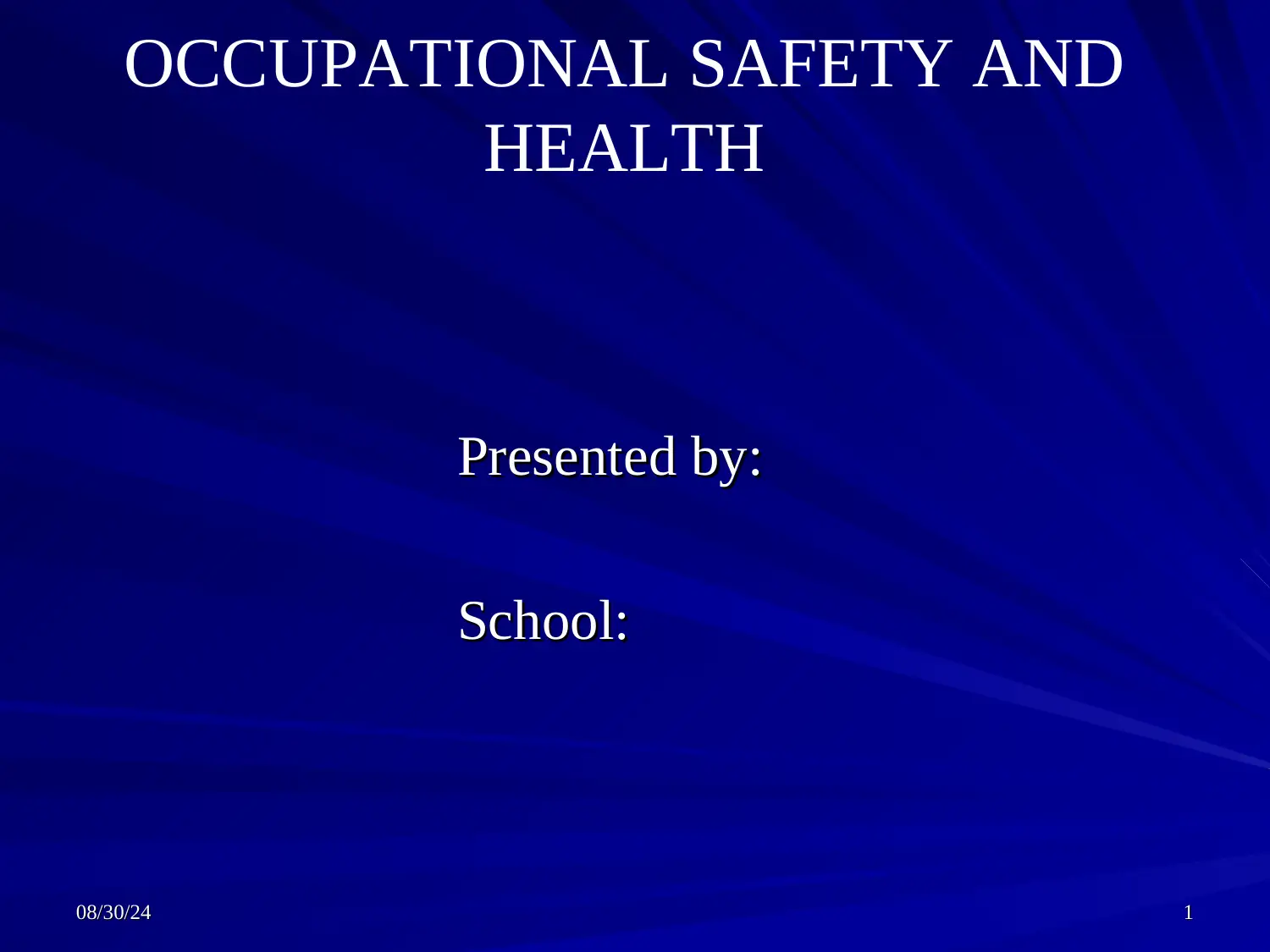
08/30/2408/30/24 11
OCCUPATIONAL SAFETY AND
HEALTH
Presented by:Presented by:
School:School:
OCCUPATIONAL SAFETY AND
HEALTH
Presented by:Presented by:
School:School:
Paraphrase This Document
Need a fresh take? Get an instant paraphrase of this document with our AI Paraphraser
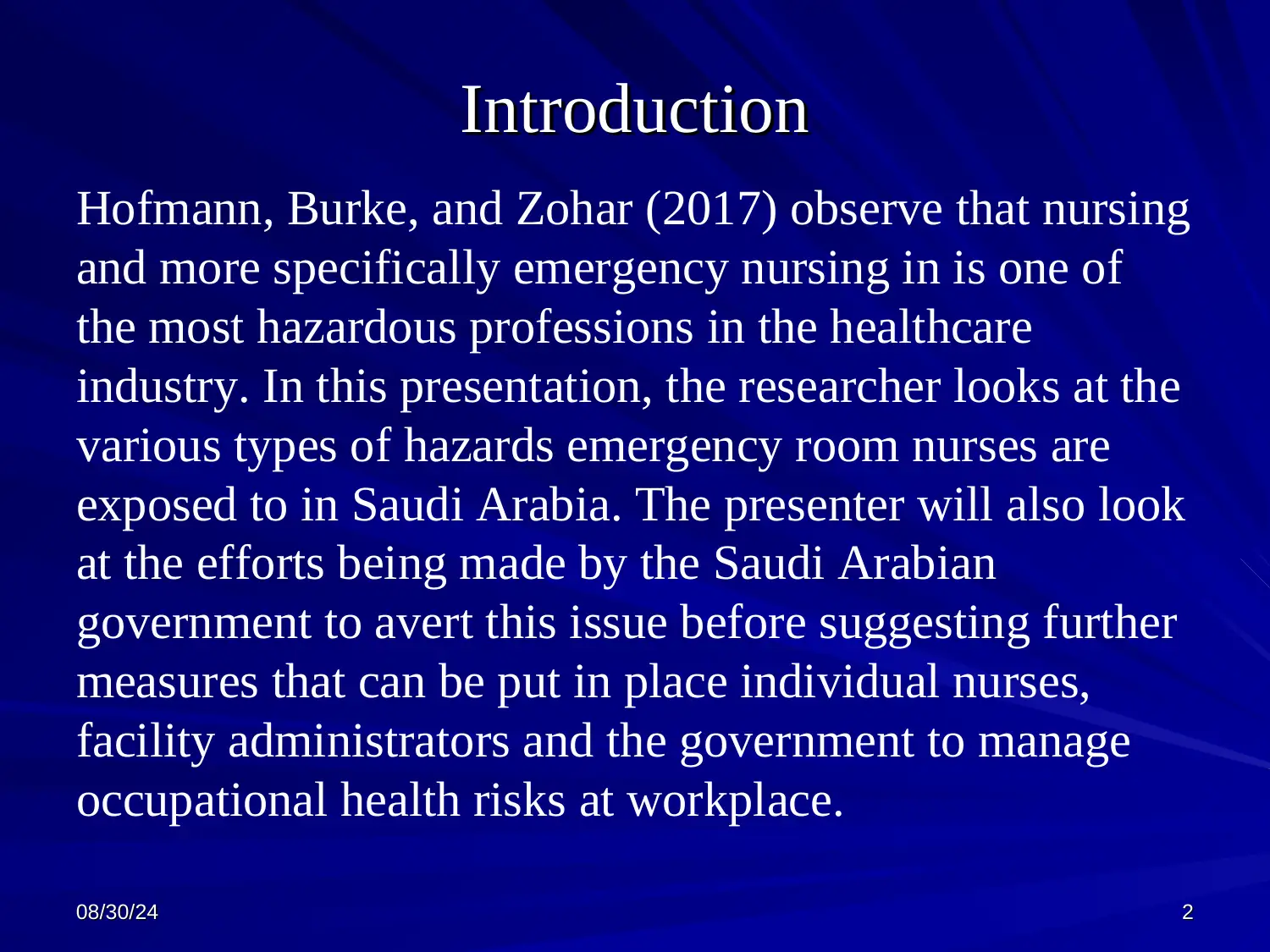
08/30/2408/30/24 22
IntroductionIntroduction
Hofmann, Burke, and Zohar (2017) observe that nursing
and more specifically emergency nursing in is one of
the most hazardous professions in the healthcare
industry. In this presentation, the researcher looks at the
various types of hazards emergency room nurses are
exposed to in Saudi Arabia. The presenter will also look
at the efforts being made by the Saudi Arabian
government to avert this issue before suggesting further
measures that can be put in place individual nurses,
facility administrators and the government to manage
occupational health risks at workplace.
IntroductionIntroduction
Hofmann, Burke, and Zohar (2017) observe that nursing
and more specifically emergency nursing in is one of
the most hazardous professions in the healthcare
industry. In this presentation, the researcher looks at the
various types of hazards emergency room nurses are
exposed to in Saudi Arabia. The presenter will also look
at the efforts being made by the Saudi Arabian
government to avert this issue before suggesting further
measures that can be put in place individual nurses,
facility administrators and the government to manage
occupational health risks at workplace.
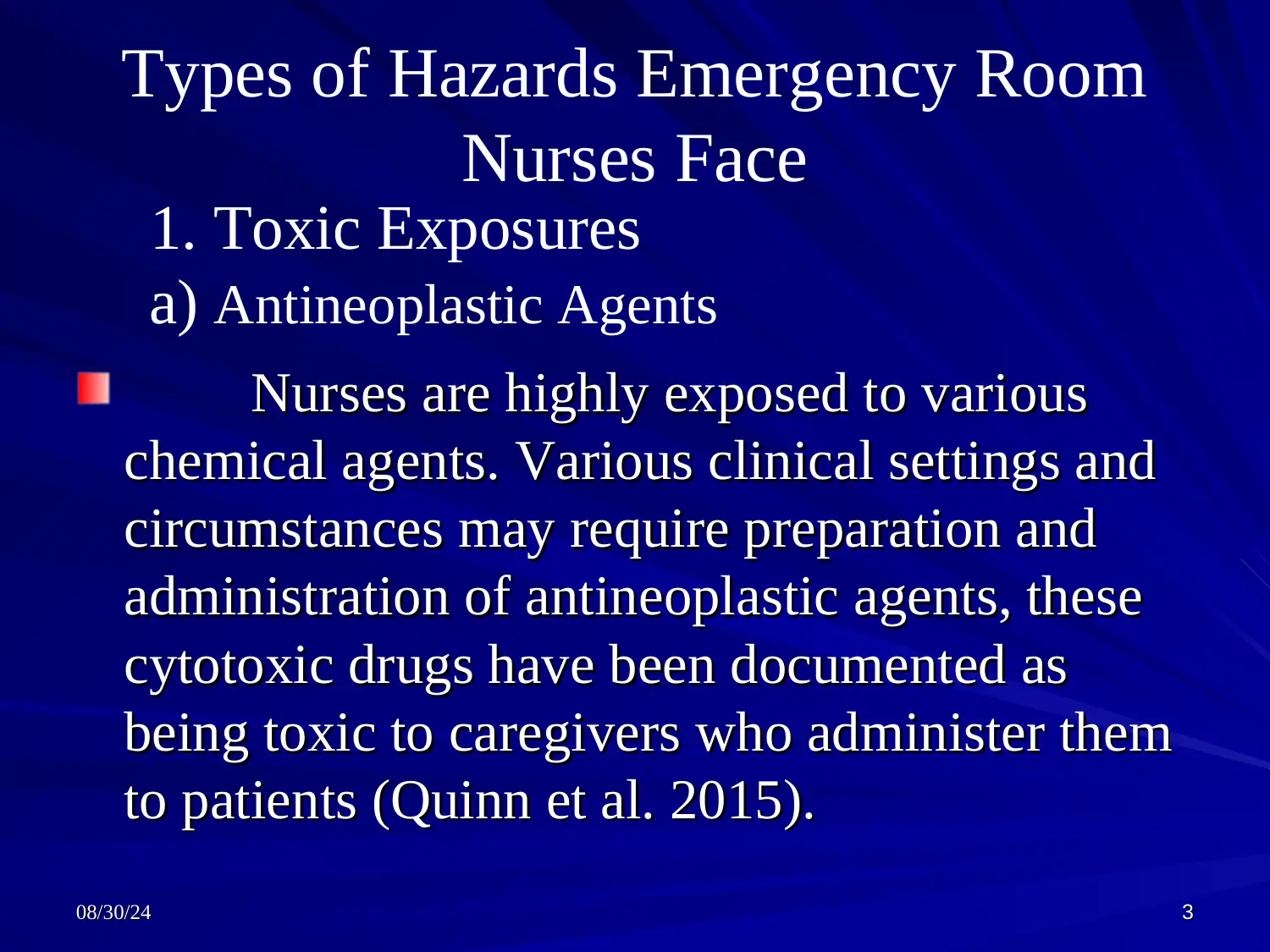
Types of Hazards Emergency Room
Nurses Face
Nurses are highly exposed to variousNurses are highly exposed to various
chemical agents. Various clinical settings andchemical agents. Various clinical settings and
circumstances may require preparation andcircumstances may require preparation and
administration of antineoplastic agents, theseadministration of antineoplastic agents, these
cytotoxic drugs have been documented ascytotoxic drugs have been documented as
being toxic to caregivers who administer thembeing toxic to caregivers who administer them
to patients (Quinn et al. 2015).to patients (Quinn et al. 2015).
08/30/2408/30/24 33
1. Toxic Exposures
a) Antineoplastic Agents
Nurses Face
Nurses are highly exposed to variousNurses are highly exposed to various
chemical agents. Various clinical settings andchemical agents. Various clinical settings and
circumstances may require preparation andcircumstances may require preparation and
administration of antineoplastic agents, theseadministration of antineoplastic agents, these
cytotoxic drugs have been documented ascytotoxic drugs have been documented as
being toxic to caregivers who administer thembeing toxic to caregivers who administer them
to patients (Quinn et al. 2015).to patients (Quinn et al. 2015).
08/30/2408/30/24 33
1. Toxic Exposures
a) Antineoplastic Agents
⊘ This is a preview!⊘
Do you want full access?
Subscribe today to unlock all pages.

Trusted by 1+ million students worldwide
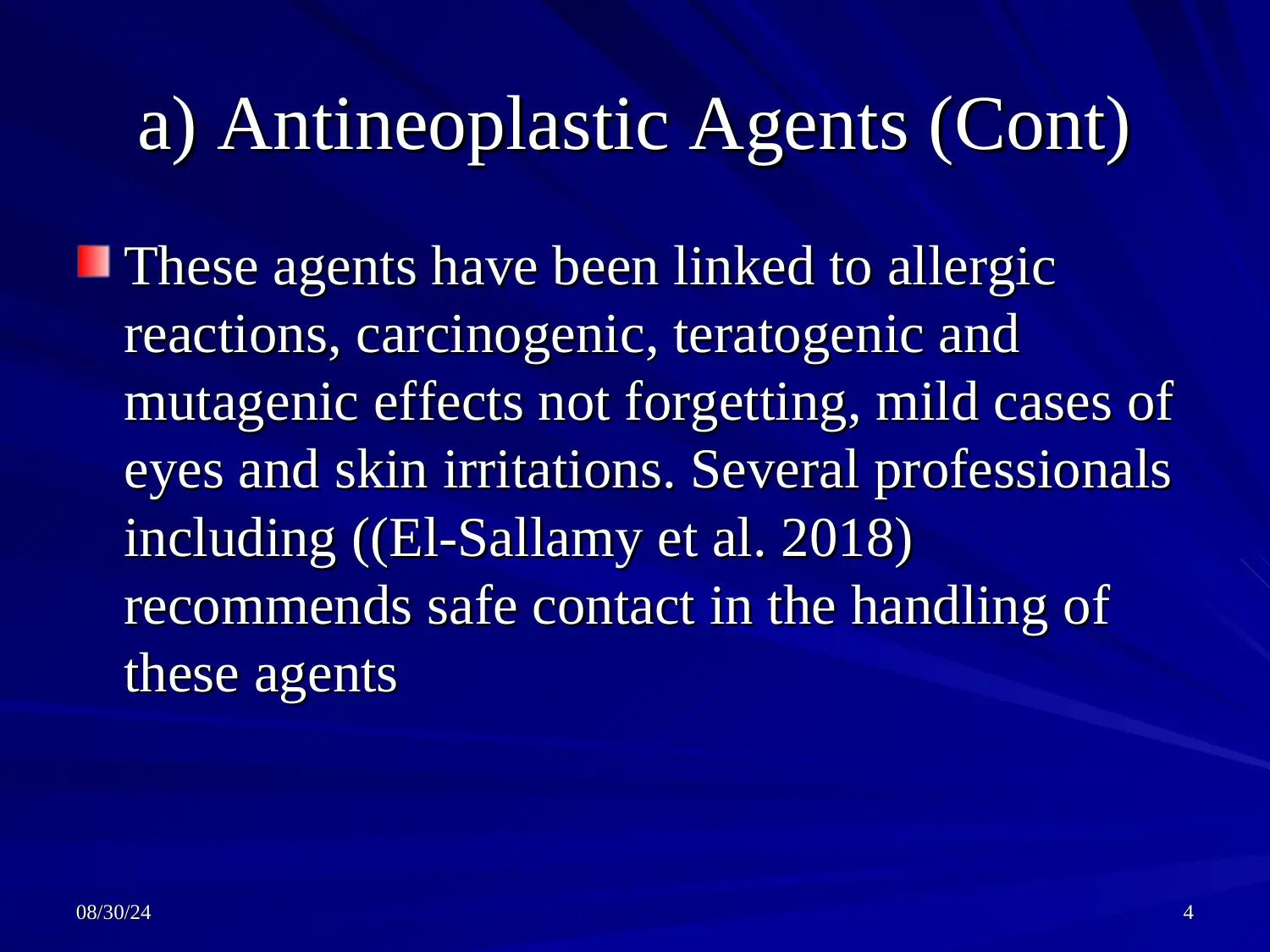
a) Antineoplastic Agents (Cont)a) Antineoplastic Agents (Cont)
These agents have been linked to allergicThese agents have been linked to allergic
reactions, carcinogenic, teratogenic andreactions, carcinogenic, teratogenic and
mutagenic effects not forgetting, mild cases ofmutagenic effects not forgetting, mild cases of
eyes and skin irritations. Several professionalseyes and skin irritations. Several professionals
including ((El-Sallamy et al. 2018)including ((El-Sallamy et al. 2018)
recommends safe contact in the handling ofrecommends safe contact in the handling of
these agentsthese agents
08/30/2408/30/24 44
These agents have been linked to allergicThese agents have been linked to allergic
reactions, carcinogenic, teratogenic andreactions, carcinogenic, teratogenic and
mutagenic effects not forgetting, mild cases ofmutagenic effects not forgetting, mild cases of
eyes and skin irritations. Several professionalseyes and skin irritations. Several professionals
including ((El-Sallamy et al. 2018)including ((El-Sallamy et al. 2018)
recommends safe contact in the handling ofrecommends safe contact in the handling of
these agentsthese agents
08/30/2408/30/24 44
Paraphrase This Document
Need a fresh take? Get an instant paraphrase of this document with our AI Paraphraser
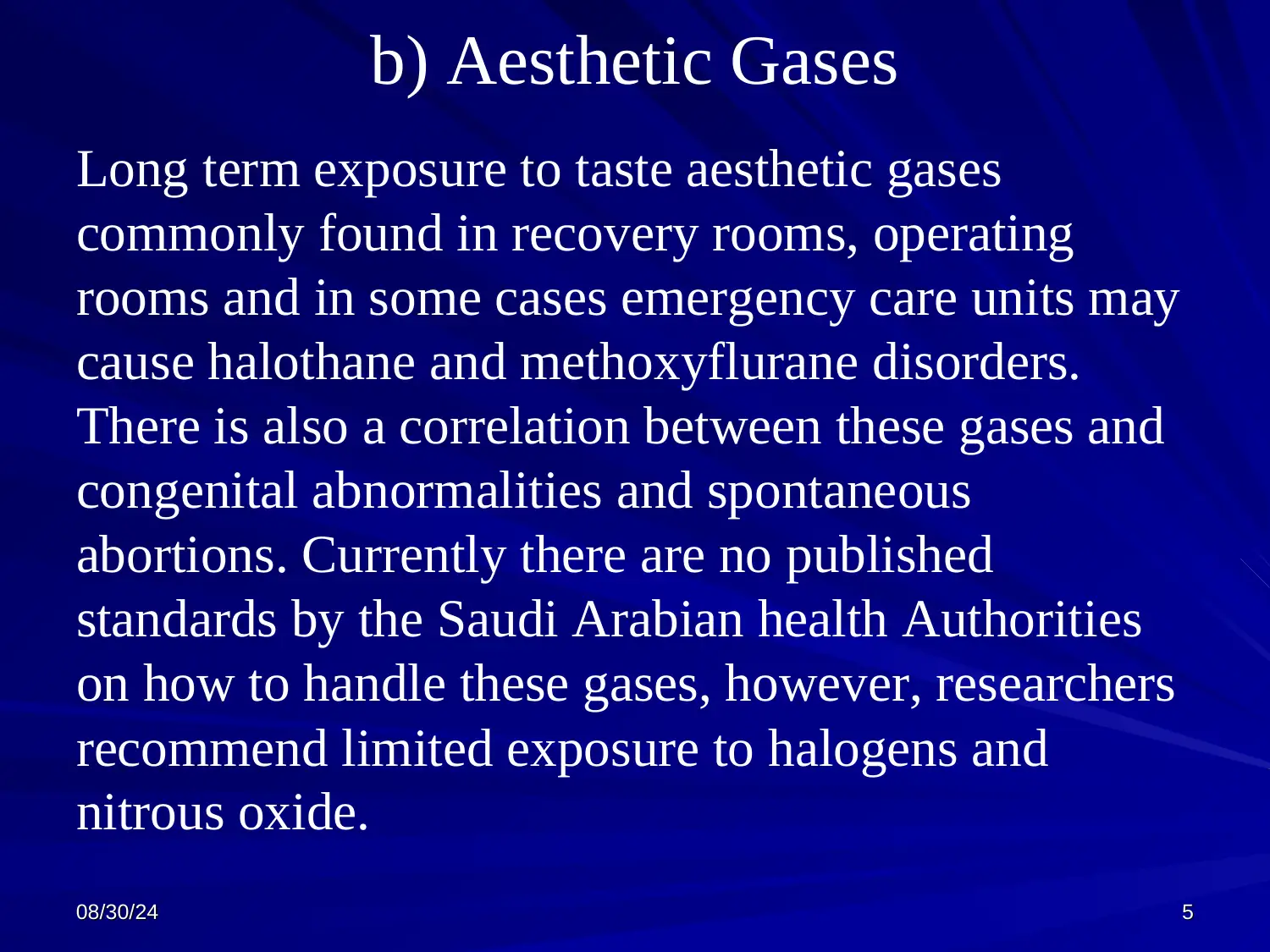
b) Aesthetic Gases
Long term exposure to taste aesthetic gases
commonly found in recovery rooms, operating
rooms and in some cases emergency care units may
cause halothane and methoxyflurane disorders.
There is also a correlation between these gases and
congenital abnormalities and spontaneous
abortions. Currently there are no published
standards by the Saudi Arabian health Authorities
on how to handle these gases, however, researchers
recommend limited exposure to halogens and
nitrous oxide.
08/30/2408/30/24 55
Long term exposure to taste aesthetic gases
commonly found in recovery rooms, operating
rooms and in some cases emergency care units may
cause halothane and methoxyflurane disorders.
There is also a correlation between these gases and
congenital abnormalities and spontaneous
abortions. Currently there are no published
standards by the Saudi Arabian health Authorities
on how to handle these gases, however, researchers
recommend limited exposure to halogens and
nitrous oxide.
08/30/2408/30/24 55
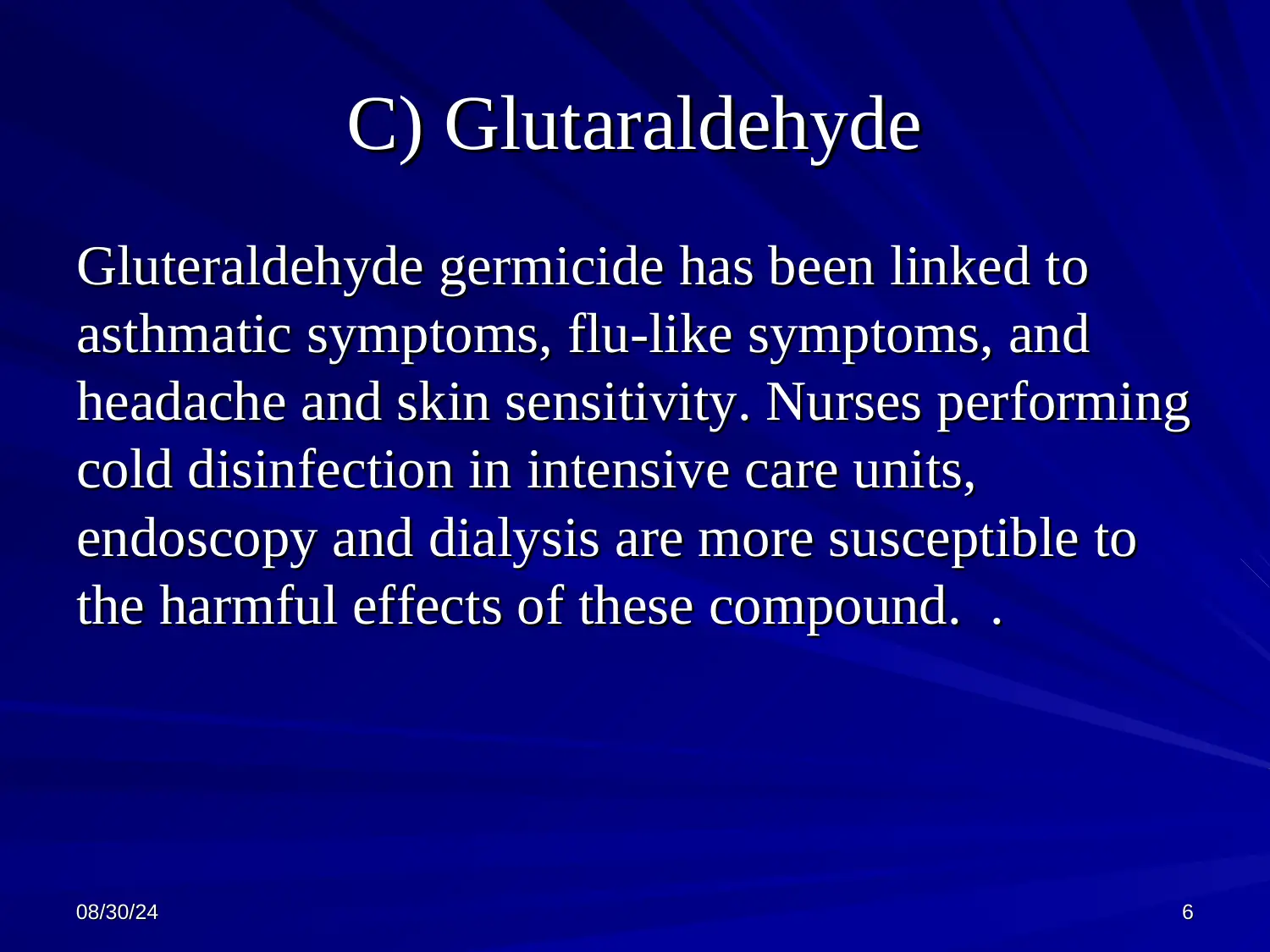
C) GlutaraldehydeC) Glutaraldehyde
Gluteraldehyde germicide has been linked toGluteraldehyde germicide has been linked to
asthmatic symptoms, flu-like symptoms, andasthmatic symptoms, flu-like symptoms, and
headache and skin sensitivity. Nurses performingheadache and skin sensitivity. Nurses performing
cold disinfection in intensive care units,cold disinfection in intensive care units,
endoscopy and dialysis are more susceptible toendoscopy and dialysis are more susceptible to
the harmful effects of these compound. .the harmful effects of these compound. .
08/30/2408/30/24 66
Gluteraldehyde germicide has been linked toGluteraldehyde germicide has been linked to
asthmatic symptoms, flu-like symptoms, andasthmatic symptoms, flu-like symptoms, and
headache and skin sensitivity. Nurses performingheadache and skin sensitivity. Nurses performing
cold disinfection in intensive care units,cold disinfection in intensive care units,
endoscopy and dialysis are more susceptible toendoscopy and dialysis are more susceptible to
the harmful effects of these compound. .the harmful effects of these compound. .
08/30/2408/30/24 66
⊘ This is a preview!⊘
Do you want full access?
Subscribe today to unlock all pages.

Trusted by 1+ million students worldwide
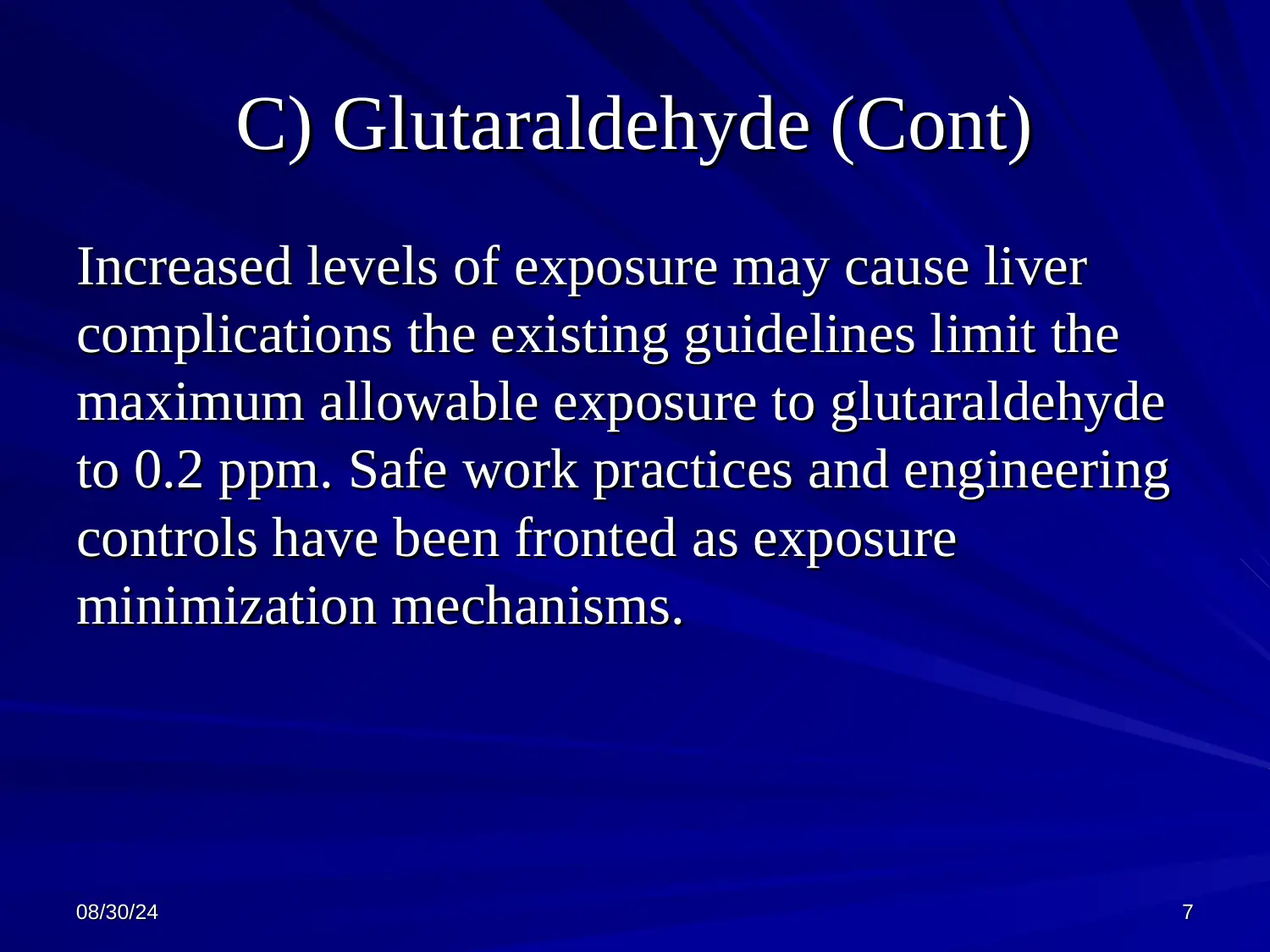
C) Glutaraldehyde (Cont)C) Glutaraldehyde (Cont)
Increased levels of exposure may cause liverIncreased levels of exposure may cause liver
complications the existing guidelines limit thecomplications the existing guidelines limit the
maximum allowable exposure to glutaraldehydemaximum allowable exposure to glutaraldehyde
to 0.2 ppm. Safe work practices and engineeringto 0.2 ppm. Safe work practices and engineering
controls have been fronted as exposurecontrols have been fronted as exposure
minimization mechanisms.minimization mechanisms.
08/30/2408/30/24 77
Increased levels of exposure may cause liverIncreased levels of exposure may cause liver
complications the existing guidelines limit thecomplications the existing guidelines limit the
maximum allowable exposure to glutaraldehydemaximum allowable exposure to glutaraldehyde
to 0.2 ppm. Safe work practices and engineeringto 0.2 ppm. Safe work practices and engineering
controls have been fronted as exposurecontrols have been fronted as exposure
minimization mechanisms.minimization mechanisms.
08/30/2408/30/24 77
Paraphrase This Document
Need a fresh take? Get an instant paraphrase of this document with our AI Paraphraser
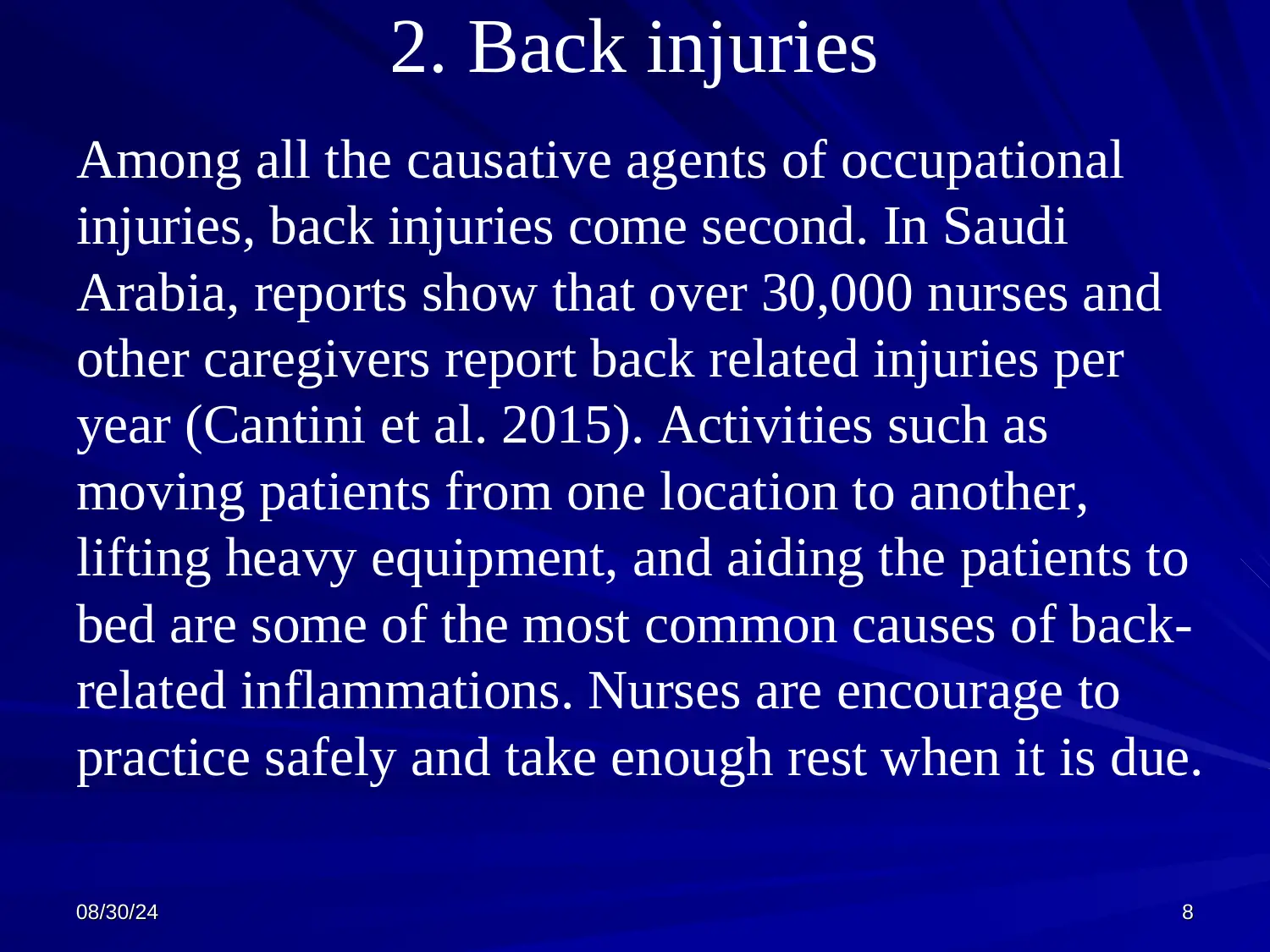
2. Back injuries
Among all the causative agents of occupational
injuries, back injuries come second. In Saudi
Arabia, reports show that over 30,000 nurses and
other caregivers report back related injuries per
year (Cantini et al. 2015). Activities such as
moving patients from one location to another,
lifting heavy equipment, and aiding the patients to
bed are some of the most common causes of back-
related inflammations. Nurses are encourage to
practice safely and take enough rest when it is due.
08/30/2408/30/24 88
Among all the causative agents of occupational
injuries, back injuries come second. In Saudi
Arabia, reports show that over 30,000 nurses and
other caregivers report back related injuries per
year (Cantini et al. 2015). Activities such as
moving patients from one location to another,
lifting heavy equipment, and aiding the patients to
bed are some of the most common causes of back-
related inflammations. Nurses are encourage to
practice safely and take enough rest when it is due.
08/30/2408/30/24 88
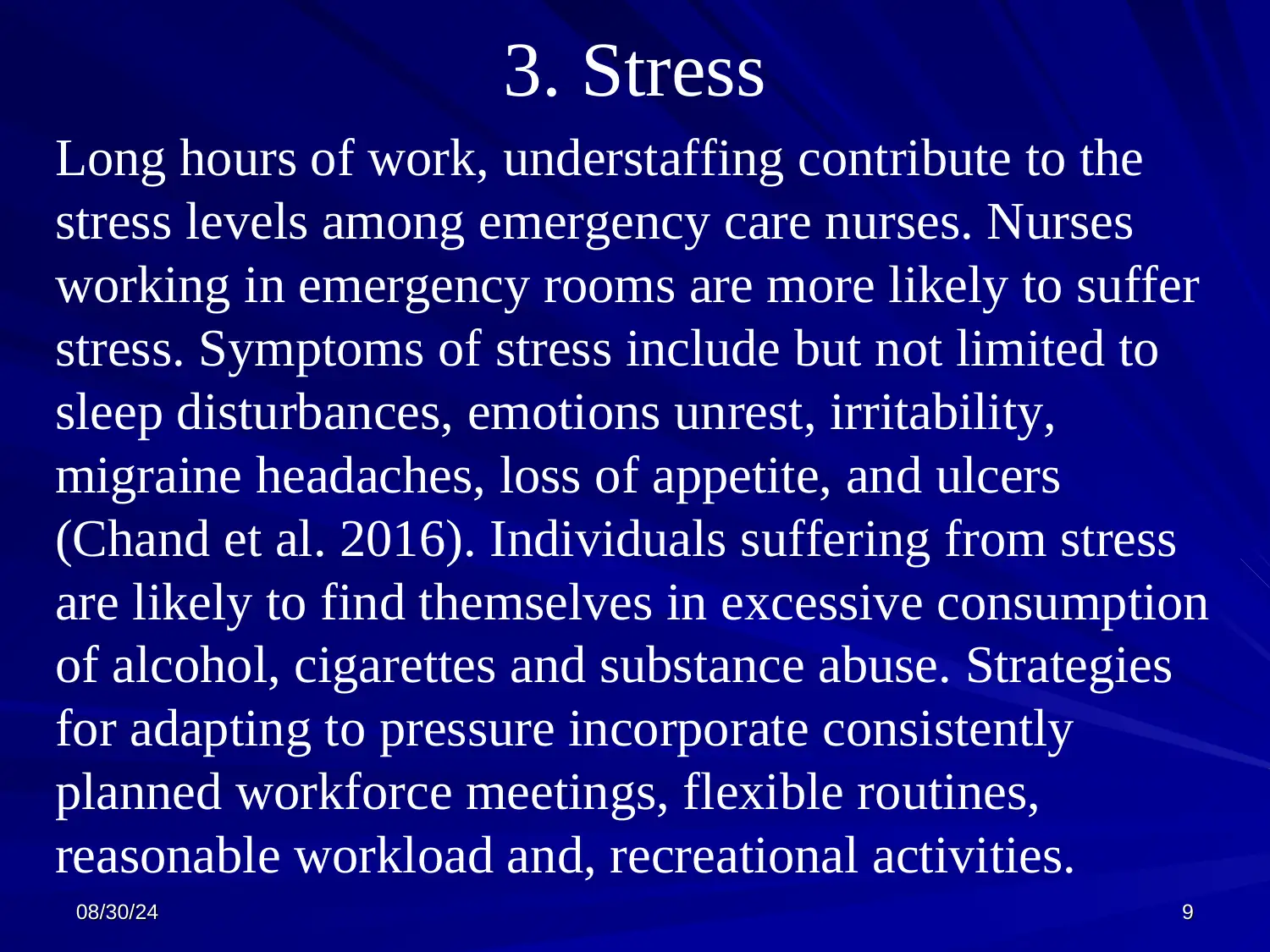
3. Stress
Long hours of work, understaffing contribute to the
stress levels among emergency care nurses. Nurses
working in emergency rooms are more likely to suffer
stress. Symptoms of stress include but not limited to
sleep disturbances, emotions unrest, irritability,
migraine headaches, loss of appetite, and ulcers
(Chand et al. 2016). Individuals suffering from stress
are likely to find themselves in excessive consumption
of alcohol, cigarettes and substance abuse. Strategies
for adapting to pressure incorporate consistently
planned workforce meetings, flexible routines,
reasonable workload and, recreational activities.
08/30/2408/30/24 99
Long hours of work, understaffing contribute to the
stress levels among emergency care nurses. Nurses
working in emergency rooms are more likely to suffer
stress. Symptoms of stress include but not limited to
sleep disturbances, emotions unrest, irritability,
migraine headaches, loss of appetite, and ulcers
(Chand et al. 2016). Individuals suffering from stress
are likely to find themselves in excessive consumption
of alcohol, cigarettes and substance abuse. Strategies
for adapting to pressure incorporate consistently
planned workforce meetings, flexible routines,
reasonable workload and, recreational activities.
08/30/2408/30/24 99
⊘ This is a preview!⊘
Do you want full access?
Subscribe today to unlock all pages.

Trusted by 1+ million students worldwide
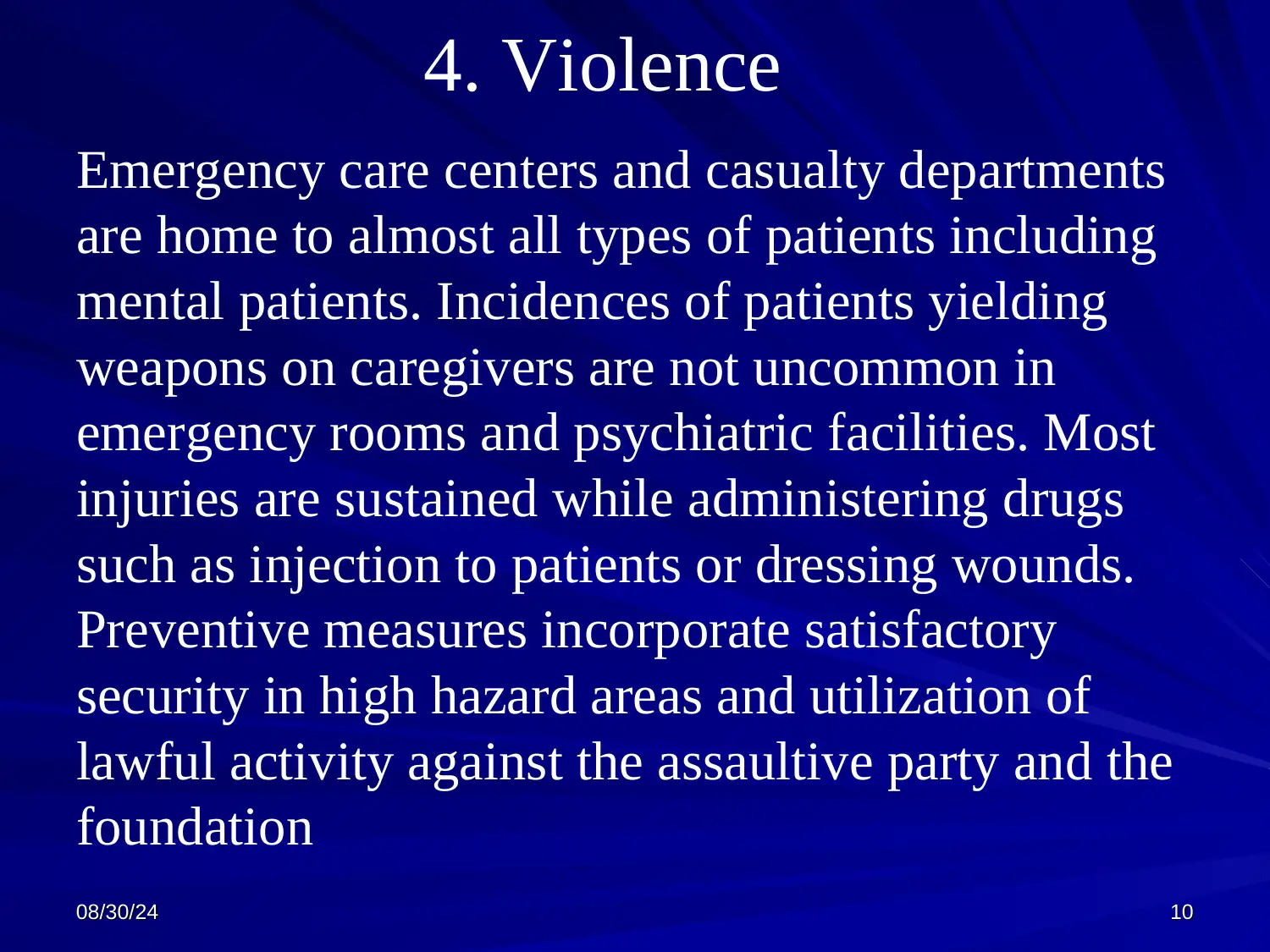
4. Violence
Emergency care centers and casualty departments
are home to almost all types of patients including
mental patients. Incidences of patients yielding
weapons on caregivers are not uncommon in
emergency rooms and psychiatric facilities. Most
injuries are sustained while administering drugs
such as injection to patients or dressing wounds.
Preventive measures incorporate satisfactory
security in high hazard areas and utilization of
lawful activity against the assaultive party and the
foundation
08/30/2408/30/24 1010
Emergency care centers and casualty departments
are home to almost all types of patients including
mental patients. Incidences of patients yielding
weapons on caregivers are not uncommon in
emergency rooms and psychiatric facilities. Most
injuries are sustained while administering drugs
such as injection to patients or dressing wounds.
Preventive measures incorporate satisfactory
security in high hazard areas and utilization of
lawful activity against the assaultive party and the
foundation
08/30/2408/30/24 1010
Paraphrase This Document
Need a fresh take? Get an instant paraphrase of this document with our AI Paraphraser
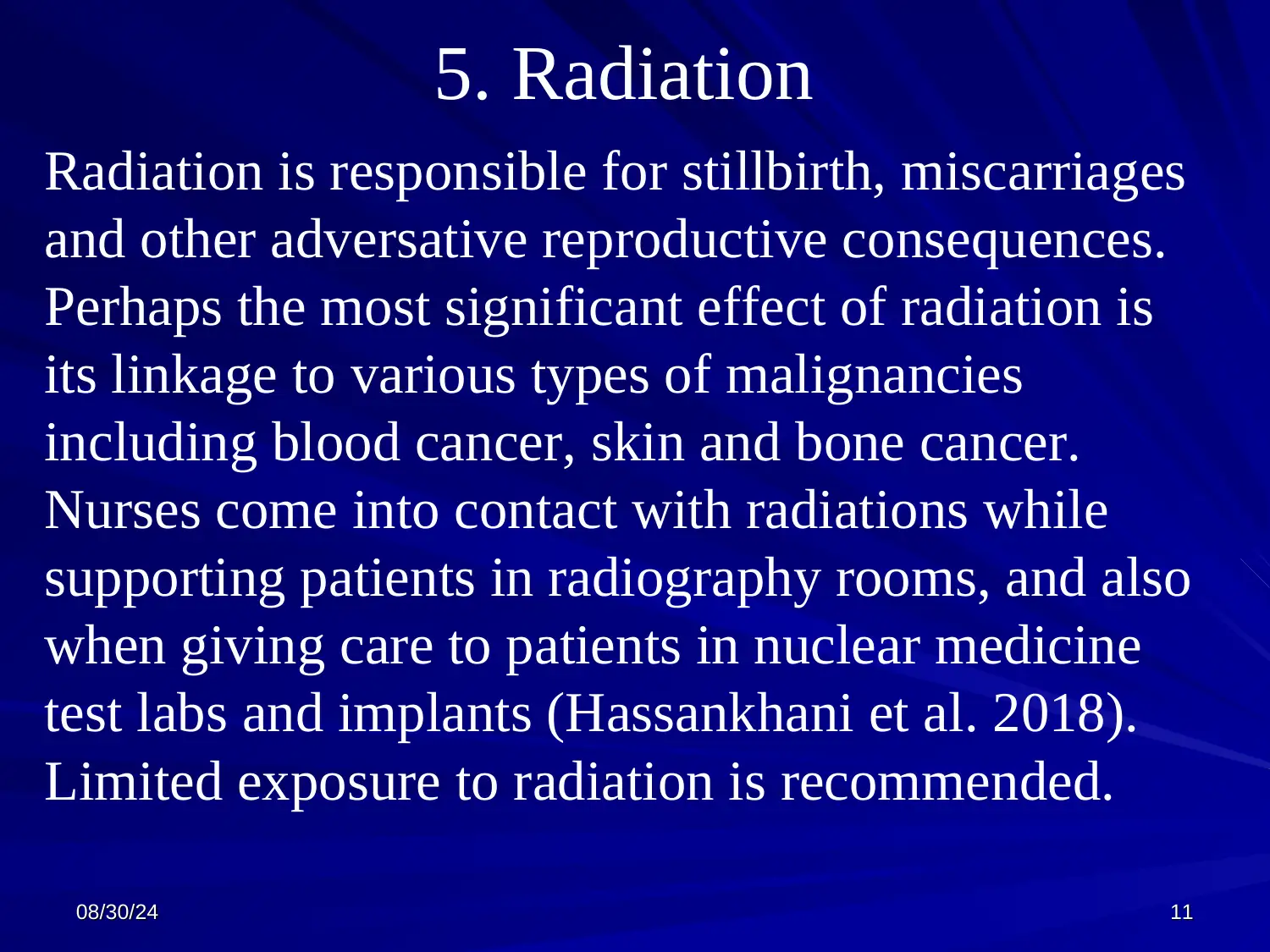
5. Radiation
Radiation is responsible for stillbirth, miscarriages
and other adversative reproductive consequences.
Perhaps the most significant effect of radiation is
its linkage to various types of malignancies
including blood cancer, skin and bone cancer.
Nurses come into contact with radiations while
supporting patients in radiography rooms, and also
when giving care to patients in nuclear medicine
test labs and implants (Hassankhani et al. 2018).
Limited exposure to radiation is recommended.
08/30/2408/30/24 1111
Radiation is responsible for stillbirth, miscarriages
and other adversative reproductive consequences.
Perhaps the most significant effect of radiation is
its linkage to various types of malignancies
including blood cancer, skin and bone cancer.
Nurses come into contact with radiations while
supporting patients in radiography rooms, and also
when giving care to patients in nuclear medicine
test labs and implants (Hassankhani et al. 2018).
Limited exposure to radiation is recommended.
08/30/2408/30/24 1111
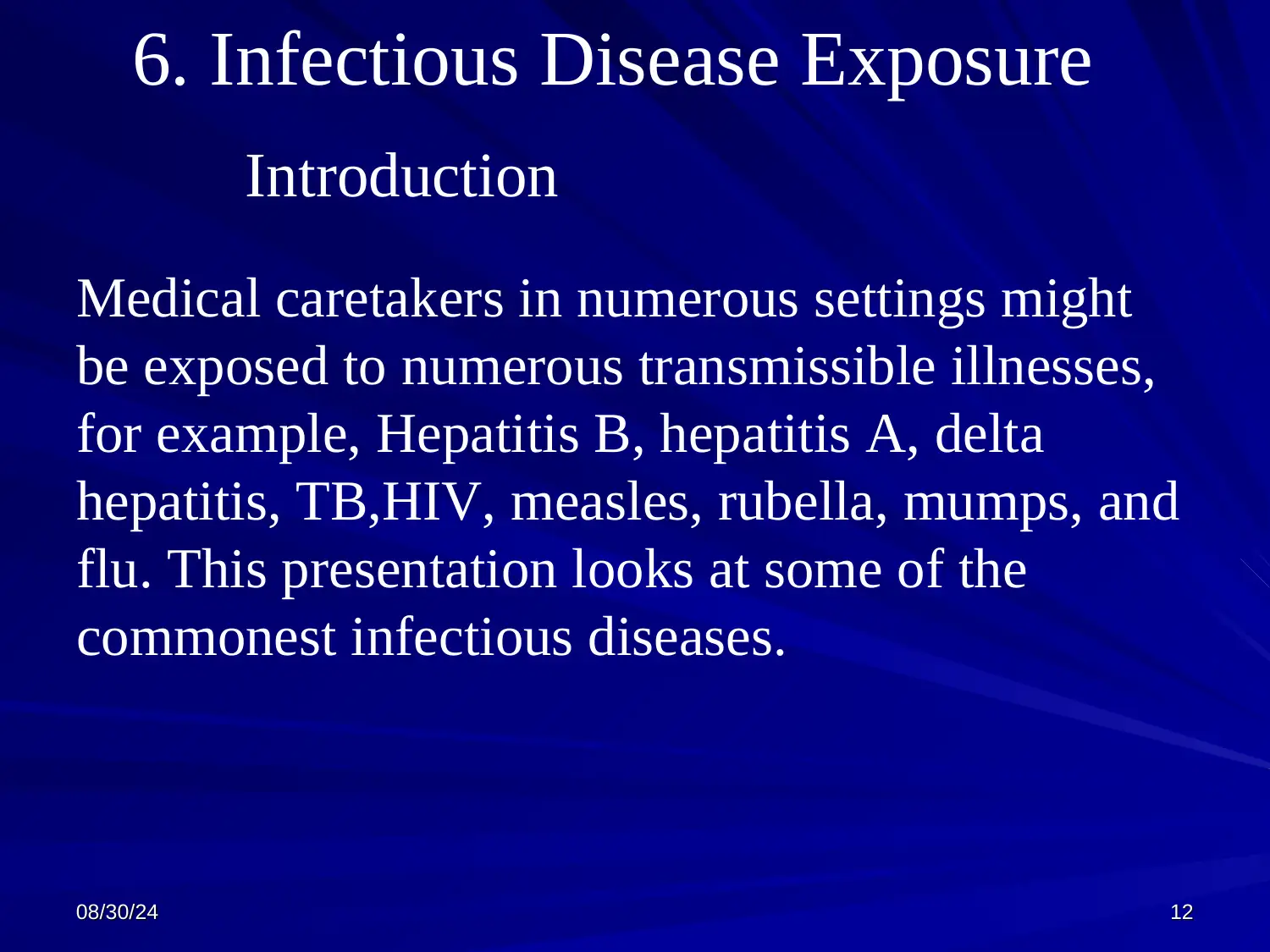
6. Infectious Disease Exposure
Medical caretakers in numerous settings might
be exposed to numerous transmissible illnesses,
for example, Hepatitis B, hepatitis A, delta
hepatitis, TB,HIV, measles, rubella, mumps, and
flu. This presentation looks at some of the
commonest infectious diseases.
08/30/2408/30/24 1212
Introduction
Medical caretakers in numerous settings might
be exposed to numerous transmissible illnesses,
for example, Hepatitis B, hepatitis A, delta
hepatitis, TB,HIV, measles, rubella, mumps, and
flu. This presentation looks at some of the
commonest infectious diseases.
08/30/2408/30/24 1212
Introduction
⊘ This is a preview!⊘
Do you want full access?
Subscribe today to unlock all pages.

Trusted by 1+ million students worldwide
1 out of 28
Your All-in-One AI-Powered Toolkit for Academic Success.
+13062052269
info@desklib.com
Available 24*7 on WhatsApp / Email
![[object Object]](/_next/static/media/star-bottom.7253800d.svg)
Unlock your academic potential
Copyright © 2020–2025 A2Z Services. All Rights Reserved. Developed and managed by ZUCOL.
